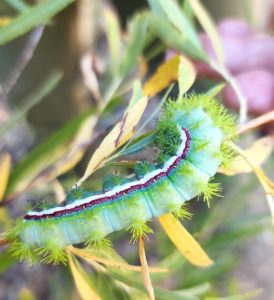
Photo credit: Lars Emil J. Dunseth
Io Moth: The Mysterious Moth
New Mexico is home to the dazzling and mysterious Io moth (Automeris io). Known for its vibrant coloration and striking defensive adaptations, this silk moth is also notable for its fascinating overwintering habits. Let’s peer into the life and characteristics of this beautiful moth, particularly how it survives the winter months.
Beautiful Defense Mechanisms
The Io moth is a medium to large silk moth, belonging to the family Saturniidae which includes other moths such as the cecropia, luna and polyphemus moths. The adults have an impressive wingspan of 2.5 to 3.5 inches. The male is typically bright yellow with distinctive eyespots on its hindwings, while females exhibit a more subtle reddish-brown hue. These eyespots are a clever defense mechanism, designed to startle predators by mimicking the eyes of larger animals when the moth feels threatened.

Io Caterpillar (Automeris io neomexicana) Photo by Christie Collins
Life Cycle of the Io Moth
The Io moth undergoes a complete metamorphosis with four life stages: egg, larva, pupa, and adult. Adults emerge from their cocoons in late spring or early summer and live only for about a week. They are nocturnal and do not feed, focusing their short lifespan on reproduction.
Females lay clusters of eggs on the underside of leaves or on plant stems. They are generalists meaning they will use a variety of plants such as oak, willow, redbud and fruit trees. The larvae, known as Io caterpillars, are equally fascinating but should be approached with caution. Covered in spines containing venom, these caterpillars can cause painful stings.
Overwintering: A Time for Survival
One of the most intriguing aspects of the Io moth’s life cycle is how it overwinters. As temperatures drop, the larvae spin silken cocoons in which they pupate. These cocoons, often hidden in leaf litter or attached to plants, act as protective capsules during the cold months.
Inside the cocoon, the Io moth undergoes diapause, a state of suspended development triggered by environmental cues such as temperature and day length. Diapause is a critical adaptation, allowing the pupae to conserve energy and survive the winter until conditions are favorable for emergence.
This overwintering strategy showcases the Io moth’s resilience. By synchronizing their life cycle with seasonal changes, they ensure that adults emerge when food sources, and mates are abundant.
Ecological Significance
Io moths play a vital role in their ecosystems. As caterpillars, they serve as a food source for predators like birds and small mammals (if their spiny defenses fail). The adults, though short-lived, contribute to pollination and attract attention for their sheer beauty, which many people love to capture on camera which in turn brings awareness for environmental education and conservation.

Photo credit: W. Krupsaw
Protecting the Io Moth
While the Io moth is not currently listed as endangered, climate change, habitat loss and pesticide use threaten its populations. Protecting their overwintering sites, such as leaf litter and wooded areas, is crucial for their survival. So, this winter remember to “Leave the Leaves”!
Article by Christie Collins


